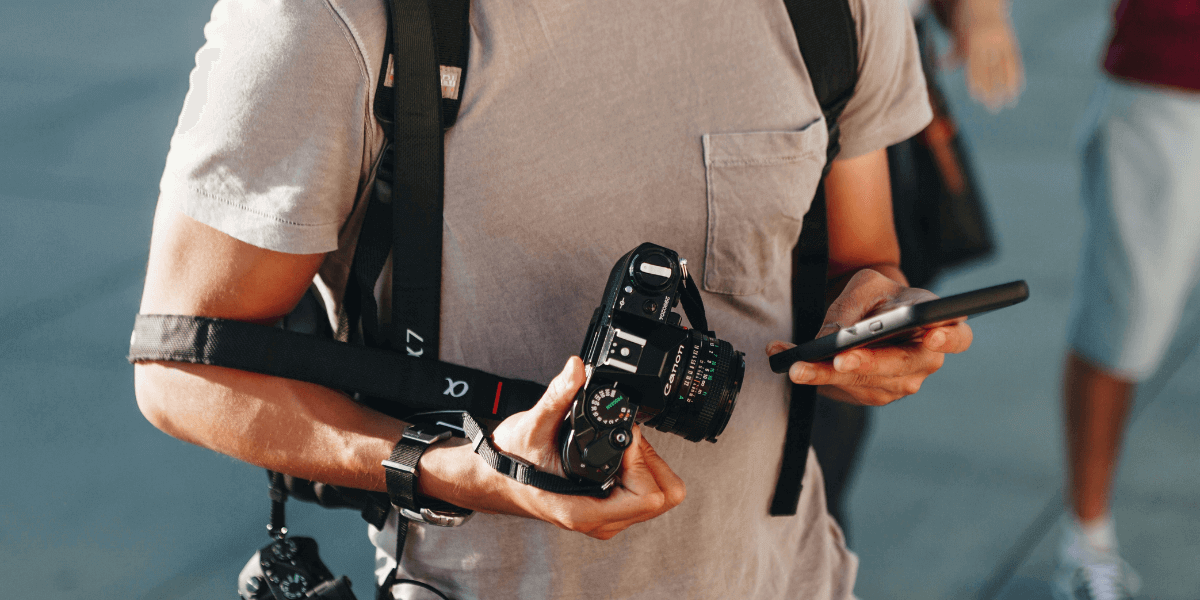How To Get Clients as a Freelance Copywriter
Discover how to get clients as a freelance copywriter in the UK and start saving on unnecessary conversion fees with Wise Business.

If you're a freelance photographer in the UK, building a steady pipeline of clients can feel like trying to catch lightning in a bottle - but just because it won’t happen in a flash, doesn’t mean it can’t be done in time.
This guide gives you a clear, practical medium-to-long-term plan for how to get clients as a freelance photographer, from defining your ideal customers to pitching, outreach, and following up after the initial reach-out.
And when you start landing clients, you'll want a simple way to invoice and get paid from anywhere. That's where a Wise Business account can help, with multi-currency details, transparent conversion, and easy bookkeeping integrations, allowing you to keep the money side tidy while you focus on the work.
| Topic | Summary Note |
|---|---|
| 🎯 Step 1: Define your ideal customer | Identify your specific target client (ICP) to focus your marketing, portfolio, and pricing effectively. |
| ✍️ Step 2: Tailor your pitch | Customise your sales pitch to the ICP, highlighting client outcomes (not gear), clear packages, and relevant examples. |
| 📍 Step 3: Increase your visibility | Be consistently active on platforms where your ICP is, such as your website, Google Business Profile, and niche-specific social media. |
| 📤 Step 4: Create an outreach plan | Develop a routine for proactively contacting a targeted list of prospects with a personalised, valuable message. |
| 🔄 Step 5: Be persistent with follow-ups | Use a polite, consistent follow-up schedule, as most bookings require it. After a job, ask for a testimonial. |
If you're wondering how to get clients as a freelance photographer, start by narrowing the field.
An Ideal Customer Profile (ICP) is a short description of the client you serve best. It stops you from trying to please everyone and helps you focus your marketing, pricing, and outreach.
This clarity makes targeting the right client much easier. It shapes the portfolio you show, the stories you tell1, and where you spend time online. It also helps you say "no" to poor-fit enquiries, freeing up time for the work you want more of.
Think in terms of use case and buyer context:
Weddings & families: couples who value storytelling and albums. Bookings start 6–12 months out, with decisions influenced by venue coordinators and friends' recommendations.
Headshots & personal branding: founders, lawyers, and recruiters who want consistent studio-quality images on LinkedIn and their websites. Decisions are often made fast with recurring updates every 6–12 months.
SMEs & e-commerce: product shoots, lifestyle shots, and social content. Needs include consistent lighting, colour accuracy, transparent backgrounds, and quick turnaround, while decisions are made by marketing managers.
Property & hospitality: estate agents, Airbnb hosts, hotels, restaurants. Needs include fast delivery, dusk exteriors, and vertical formats for listing portals.
Generic pitches get generic results. Once you've defined your ICP, tailor how you present your value. That's how to pitch your services without sounding like every other photographer.
Clients care about what the images will achieve: more enquiries, a consistent brand look, listings that convert, or happy guests who share photos. Keep your kit to the last paragraph (or a sidebar on your website).
Use examples that resemble their needs. For a corporate client, talk about a smooth on-site process, consistent lighting for 50 employees, data protection, and fast delivery. For a wedding couple, talk about timelines, family shot lists, and how you keep portraits relaxed.
Offer clear packages with scope, usage rights, turnaround, and optional add-ons. If you charge day rates, add a few common "bundles" (e.g., half-day product shoot + 2 sets + basic retouching + social crops).
One testimonial snippet and one mini case study beat a page of text. For example: "After our spring refresh, product conversion improved and we re-booked for autumn." Even a short line helps.
Focus on short sentences and try to avoid jargon if possible. It's best to go in with a friendly, confident tone. After all, you're a partner, not a vendor.
Here's a simple email framework you can use:
Keep proposals short and visual: one page with fees, usage, and delivery timeline. If they reply "not now", thank them and schedule a check-in for the future (see Step 5).
When you sell to businesses, be clear about usage and licensing. In UK law, the creator is usually the first owner of copyright2, unless you assign it in writing.
Clients typically receive a licence for specific uses (e.g., web, print, ads). That clarity prevents awkward emails later and makes your pricing easier to understand.
You don't need to be everywhere to find clients that match your ICP. Prioritise two platforms you'll show up on consistently, then add a third once the first two are working.
Create a lean site with strong niche pages (e.g., "Product Photography in Manchester" or "Corporate Headshots in Birmingham"). Embed a tight, curated portfolio and specific FAQs that mirror buyer questions ("What's included in licensing?", "How fast is delivery?").
Set up and verify a Google Business Profile (GBP) so you show up in local Search and Maps with reviews, photos, and services. GBP is free and helps customers find and trust you in local results3. Publish updates (offers, posts, events) and keep NAP details consistent.
When it comes to photography, nothing can increase your visibility as much as being on the right social media networks.
If you are not sure where to find clients, here are some tips on how to use key platforms to gain more visibility:
LinkedIn is excellent for corporate, B2B, and headshot work. Post mini case studies: 4–6 images + 2 lines on the brief and measurable outcome. Connect with office managers, marketers, and founders.
Instagram/TikTok are perfect for weddings, families, fashion, food, and hospitality. Use carousels to tell micro-stories (before/after, lighting diagram, colour chart).
Portfolio directories like PeoplePerHour, AOP (Association of Photographers) or BIPP (British Institute of Professional Photography) can work for some niches.
Partnerships beat algorithms to build a referral loop. You can team up with venues, planners, estate agents, PRs, stylists, and MUAHs.
Clients rarely just appear, so you need a light, consistent outreach routine.
Here's how to build a simple, weekly outreach habit that feels helpful (not spammy):
Build a prospect list that matches your ICP. Start with existing contacts (past clients, friends, suppliers) and add 20–30 ideal companies or venues. Note the buyer's name, email, and the specific reason you're relevant.
Research the trigger for each potential client4. This could include a new product launch, website refresh, rebrand, a hiring spree (new starters need headshots), a new menu, or a property listing surge.
Send a personalised note with something valuable4, like two layout suggestions for their About page, a 6-shot product storyboard, or a location idea near their office that suits their brand palette.
Use a light CRM or simple spreadsheet to track who you contacted, when, the follow-up date, and the outcome. Colour-code hot, warm, and cold leads. Aim for quality over volume.
Offer an easy next step. This could be a 10-minute scoping call, or send over a single-page rate card with a "starter day" offer.
Most bookings happen after the initial reachout. People get busy, and your note can easily disappear during a deadline.
Plan a simple, value-first cadence for following up after the initial reach out:
Keep each follow-up shorter than the last, add value where possible, and make it easy to say "not now". Polite persistence (not pestering) builds your reputation for reliability.
After the job, create a follow-up for the next job. Send a thank-you, deliver on time, ask for a short testimonial, and suggest a relevant next step. Retained clients beat new leads every time.
Now that you've mapped your ideal clients, shaped your pitch, shown up where they're looking, and built a follow-up rhythm, here’s how you can make getting paid easy with Wise Business.
By allowing you to hold over 40+ currencies, Wise makes payments straightforward for your UK and international clients.
You can get local account details in currencies to receive payments with ease, and create professional invoices for free directly from the app.
Need to pay crew or buy gear abroad? You can send money to 140+ countries.
And when you're on location, use the Wise Business card to spend in 150+ countries.
If you're ready to tidy up the money side and focus on creating, open a Wise Business account today.
Be Smart, Get Wise.
"I use Wise Business in the UK to pay most of my contractors, whether that’s in GBP, USD, AUD or NZD. They send me an invoice, and I just wire the money through Wise. It’s super easy - I just pop in their sort code and account details, and off it goes.”
Start with your day or half-day rate based on your costs (gear, insurance, travel, post-production time, taxes) and experience.
Add licensing for commercial usage (e.g., web-only vs. ad campaigns), because the licence defines how, where, and for how long images can be used.
UK guidance confirms the creator is typically the first owner of copyright2 (unless you assign it), so spell out licences clearly in your contract.
If you photograph identifiable people and store or process those images, you're handling personal data.
You'll need a lawful basis (often "contract" or "legitimate interests"), a concise privacy notice, and sensible retention/storage practices. The ICO cautions that consent isn't always the right basis, especially where it isn't freely given5.
Verify your Google Business Profile, upload recent work, keep your hours and services up to date, and ask happy clients for honest reviews (never incentivised).
It's free and helps you show up in local Search and Maps, while review manipulation risks warnings or restrictions3.
Sources
Sources last checked on 11th November 2025
*Please see terms of use and product availability for your region or visit Wise fees and pricing for the most up to date pricing and fee information.
This publication is provided for general information purposes and does not constitute legal, tax or other professional advice from Wise Payments Limited or its subsidiaries and its affiliates, and it is not intended as a substitute for obtaining advice from a financial advisor or any other professional.
We make no representations, warranties or guarantees, whether expressed or implied, that the content in the publication is accurate, complete or up to date.

Discover how to get clients as a freelance copywriter in the UK and start saving on unnecessary conversion fees with Wise Business.

Discover how to apply for a permit to work self-employed in Austria as a UK citizen. Our guide explains the application process, key things to note, and more.

Thinking of moving to Finland to freelance? Our 2025 guide for UK citizens explains how to apply for the Finnish residence permit for an entrepreneur.

Discover the process of paying tax as a self-employed individual or freelancer in the UK. Our guide explains all of the necessary steps in detail.

Learn how to get clients as a freelance bookkeeper in the UK in 2025 with our step-by-step guide.

Learn how to get clients as a freelance recruiter in the UK with our step-by-step guide and get paid in multiple currencies like a local with Wise.